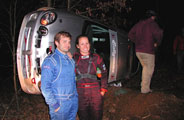Gravel Spray ------------------------------------------------- Godlike Moderator Location: ------------------------------------------------ Join Date: 07/25/2008 Posts: 157 Rally Car: ------------------------- |
Neil Brown's work is currently touring car and DTM engines, but 15 years ago they carried out engine developement work on Group A rally engines for Richard Asquith Autosport which had a small amount of support from Honda UK. The driver was usually Neil Wearden. In Group A the valve train was free at the time and as you said the v-tech apparatus was not only heavy but it's mass inside the cam cover made fitting larger cams/springs nearly impossible. The Evo was always the top choice in Group N, for many reasons. The only reason Subaru started showing up in the top of PWRC results over the past 7+ years is that they had made a big investment to lift the brand in the results. They handed over a lot of free donor cars, support and incentives to the top preparation companies to ensure the best drivers were in STI's. |
Roc pitbull Scott Carlson Senior Moderator Location: rochester, ny Join Date: 06/28/2008 Posts: 9 Rally Car: Subaru legacy (rally cross), Subaru Impreza (getting un balled up) |
I know on a honda engine (the civic si/rdx) The computer recognizes that its time for an advance or retard of both intake and exhust valves. sends a signal to the cam position sensor, cams and it will hydrolicaly advances or retards the cams to the degree it needs to be at. This is constantly happening while driving the car.
didn't read all the replys but this is how the honda |
Sorry, only registered users may post in this forum.
Rally Anarchy © 2014 Corvus Digital –
Part of the AutoShrine Network –
Problems? Send an email to the Webmaster


